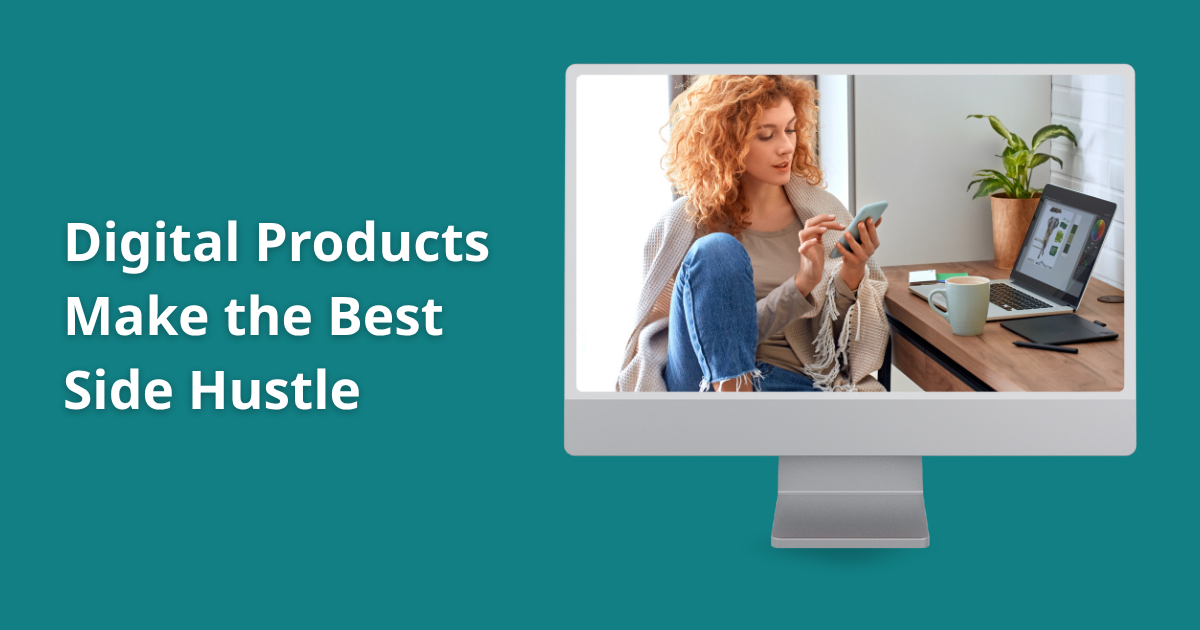Key Takeaways:
- Digital products offer high margins due to low or no cost of production and delivery.
- They’re beginner-friendly. Requiring no tech background or upfront capital to get started.
- Automation tools make them passive, enabling income while you sleep.
- Scaling is simple: One product can evolve into bundles, toolkits, or courses.
- You can reach a global audience instantly, with platforms handling sales and distribution.
Digital products are intangible goods that are sold online and delivered electronically. Examples include ebooks, templates, online courses, and downloadable planners. These products require no physical inventory, making them scalable, low-maintenance, and ideal for entrepreneurs seeking passive income streams.
Digital products are available instantly and can be sold globally without shipping logistics. This makes them especially attractive to beginners exploring side hustles. With the rise of creator platforms and automation tools, building and distributing these assets is more accessible than ever.
Why Are Digital Products the Best Side Hustle for Beginners?
Digital products are the best side hustle for beginners because they require minimal capital, no storage space, and can be created using skills you already have. You don’t need technical expertise or advanced design tools to get started.
Tools like Canva, Notion, and Google Docs allow first-time creators to build professional assets. Marketplaces like Etsy, Gumroad, and Payhip eliminate the need for a personal website. If you’re new to business, digital products offer a low-barrier entry into entrepreneurship.
Additionally, digital products fit well into the growing gig economy. Whether you’re freelancing, teaching online, or building a social media audience, creating and selling digital assets can become a valuable income stream. Many creators also bundle digital products with services like coaching or consulting to offer tiered revenue options.
5 Reasons to Start Selling Digital Products in 2025
1. Low Startup Costs
Creating and selling digital products requires almost no financial investment. Most tools used to create them are free or cost a few dollars monthly.
- Canva: Free templates and design tools.
- Google Docs: Write ebooks or workbooks.
- ChatGPT: Generate outlines, copy, and product descriptions.
Unlike physical businesses, you won’t pay for inventory, packaging, or shipping.
2. High-Profit Margins
Digital products have virtually no cost of replication. Once you create a file, you can sell it infinitely with no production or delivery fees.
Most platforms only take a small transaction fee (typically 3–10%). This leaves you with profit margins of 90% or more.
3. Passive Income Potential
Passive income means earning money with minimal ongoing effort. With automation tools, your digital products can be sold and delivered 24/7 while you sleep.
Email autoresponders, instant downloads, and checkout platforms handle the work. You focus on marketing, not fulfillment.
4. Easy to Scale
Scaling digital products doesn’t require more hours, staff, or stock. You can create bundles, sell licenses, or repurpose content into new formats.
Start with a template, expand it into a toolkit, then launch a mini-course. Everything runs from the same asset.
5. Global Reach and Automation
Platforms like Shopify, Gumroad, and Etsy allow you to sell worldwide. Language translation tools and automation systems make global expansion seamless.
Timezone? Irrelevant. You can monetize across borders without dealing with shipping or customs.
How to Start a Digital Product Side Hustle in 2025
Step 1: Choose a Niche
Pick a topic aligned with your skills, hobbies, or work experience. Validate that people are searching for solutions by checking tools like Ubersuggest or Google Trends.
Step 2: Validate the Demand
Search marketplaces like Etsy or Creative Market. Look at bestsellers and see what’s missing or could be improved.
Step 3: Create Your Product
Use free tools (Canva, Notion, ChatGPT) to build your asset. Keep it simple and focus on usefulness.
Step 4: Publish and Promote
Host your digital product on Etsy, Gumroad, or Shopify. Share via Pinterest, TikTok, or SEO-friendly blog content.
Step 5: Automate and Scale
Set up email marketing, product bundles, and upsell funnels. Automate delivery and use feedback to improve your offers.
Best Digital Products for Beginners
- Canva templates: Social media kits, planners, resumes
- Notion planners: Business dashboards, student tools, content calendars
- Digital journals: Wellness, gratitude, fitness, finance
- Printable workbooks: Budget trackers, wedding planners, meal prep
- Ebooks and guides: Tutorials, frameworks, how-to manuals
These are easy to create, cost-effective, and beginner-friendly.
Leverage Content Marketing for Visibility
Blog posts, social media, and YouTube videos are powerful drivers of traffic. Use SEO-driven content to showcase your digital product, share tutorials, and build authority.
- Post behind-the-scenes content to your Instagram.
- Repurpose blog content into carousels or Reels.
- Use Pinterest to drive long-tail traffic to evergreen products.
Final Thoughts
Digital products make the best side hustle in 2025 because they’re simple to launch, low risk, and incredibly scalable. With tools like ChatGPT, Canva, and Notion, even beginners can turn their knowledge into a passive income business.
Whether you’re a stay-at-home parent, a creative professional, or just looking to earn extra income in your free time, the digital products side hustle offers unmatched flexibility and growth.
FAQs on Starting a Digital Product Side Hustle
What platform is best for beginners to sell digital products?
Etsy and Gumroad are top picks. Etsy has built-in traffic; Gumroad has no upfront fees.
How much can I earn selling digital products?
Many beginners earn $100–$500/month initially. Top sellers scale into five figures per month.
Do I need a website?
No. Start with marketplaces, then build your own site if you want more control.
How do I protect my products?
Use PDF locks, watermarks, and license agreements. No method is 100% theft-proof.
Can AI help me create digital products?
Absolutely. Use ChatGPT for outlines, scripts, copy, and idea validation.
